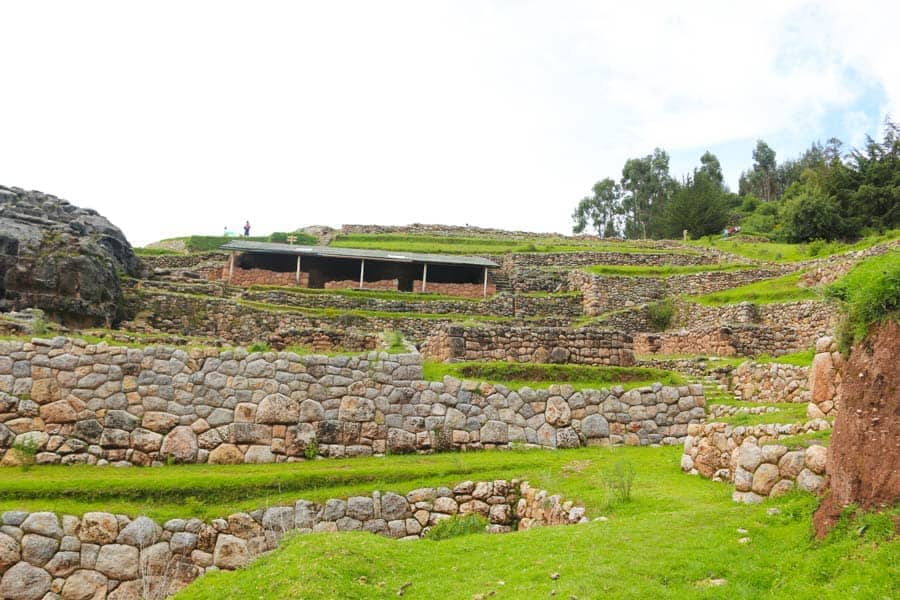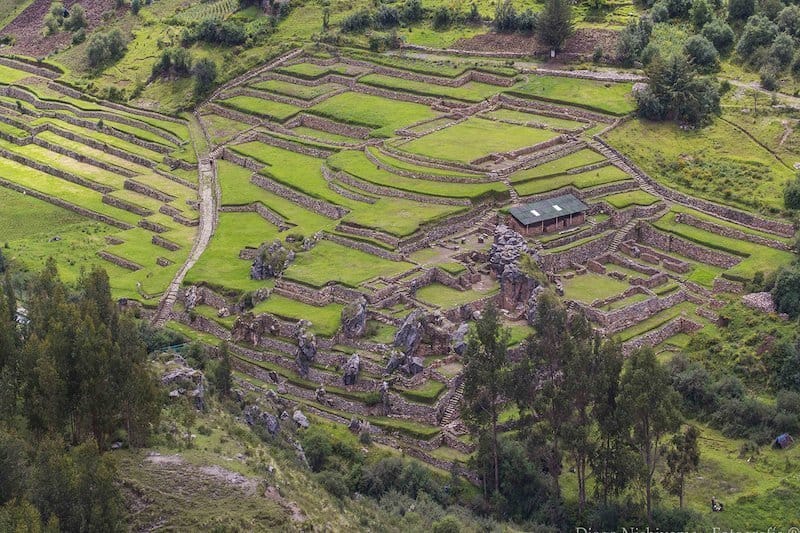Inkilltambo Archaeological Center: the sacred garden of the Incas in Cusco, a magical place, little known by mass tourism, but full of symbolism, history, and unique natural beauty. If you’re looking to explore Cusco beyond traditional sites like Machu Picchu or Sacsayhuamán, Inkilltambo offers a mystical and unforgettable experience, surrounded by nature, water channels, terraces, and ceremonial paths.
Join us to discover why this space was one of the most important sacred centers around Qosqo (ancient Cusco), and how you can easily include it in your next trip.
Inkilltambo, the hidden natural temple in the mountains of Cusco
Inkilltambo, whose name in Quechua means “place of the Inca’s garden” or “place of blooming,” is an archaeological center that served as a ritual and agricultural space during the time of the Tahuantinsuyo. It was recently restored and today can be visited for free, enjoying a peaceful walk amidst the forest, the apus, and the Andean silence.
This space stands out for its well-preserved natural environment, water channels that still flow, agricultural terraces, Inca stairways, perfectly fitted walls, and an energy that many visitors consider “spiritual.” Additionally, it is very close to the center of Cusco, making it a perfect excursion for those with half a day free and wishing to escape the noise.

What is Inkilltambo and why is it special?
Inkilltambo was a huaca or Inca ceremonial center, integrated into the Qhapaq Ñan road system, the great road network of the empire. Its function combined ritual and agricultural aspects, where the Inca and his priests worshiped nature, water, and the cycles of life.
What makes Inkilltambo special is:
- Its direct connection with the natural environment
- The ceremonial architecture adapted to the terrain
- Its isolation and tranquility, ideal for meditation or walking
- Its easy access from the center of Cusco
It is one of the few sites where you can still see water running through the ancient channels built by the Incas, which strengthens its sacred character.
History of Inkilltambo: place of worship and royal transit

The history of Inkilltambo is linked to the roads that connected Cusco with the rural areas to the east. It is believed to have been built during the time of Pachacútec, and its strategic location suggests that it served as a resting place or spiritual retreat for the Inca nobility.
Among its main uses are:
- Ceremonial center linked to agriculture and water
- Resting place for nobles on their pilgrimage routes
- Minor territorial or administrative control point
The combination of nature, hydraulic engineering, and architecture reveals the deep respect that the Incas had for the land and the elements.
Main architectural elements of Inkilltambo
Inkilltambo is composed of a variety of structures that, although not monumental, have great symbolic and functional value:
- Agricultural terraces: sacred foods were cultivated for rituals
- Water channels: still active, used for purification and irrigation
- Stone stairways: connect the different levels of the terrain
- Retaining walls and small niches: ceremonial spaces
- A carved rock in the shape of an altar: possibly used in rituals
The entire site is integrated into the mountain, without altering its shape, respecting the Andean worldview of harmony with nature.

Location of Inkilltambo: Where is it located?
The Inkilltambo Archaeological Center is located in the district of San Sebastián, province of Cusco, in the northeastern area of the city. It is part of the Sacsayhuamán Archaeological Park, although it is in a more isolated and natural section.
Average altitude: 3,600 m a.s.l.
Approximate coordinates: 13°30′S, 71°58′W
How to get to Inkilltambo from downtown Cusco?
There are several simple and economical ways to get there:
- Walk from San Blas or Qenqo: ecological route of approximately 1 hour
- Taxi to the community of Sallas or Tambomachay, then walk 15-20 minutes.
- Guided trekking tour that includes Inkilltambo and other nearby points like the Temple of the Moon or Chuspiyoq.
It is a quiet, safe, and mostly well-signposted route.
Climate in Inkilltambo: What to bring according to the season?
The climate is similar to other high Andean areas of Cusco. It is recommended:
Dry season (April – October):
- Light clothing during the day, warm clothing for the afternoon
- Trekking shoes
- Hat and sunscreen
Rainy season (November – March):
- Poncho or waterproof jacket
- Walking sticks
- Extra care with slippery paths
Essential all year round:
- Water
- Camera or cell phone with good battery
- Natural snacks
- Layered clothing
Recommendations for visiting Inkilltambo for the first time
- Free entrance, no tourist ticket required
- Best to visit on weekdays, with fewer crowds
- Bring everything you need, there are no shops along the way
- Be respectful of the environment: do not climb walls or alter water channels
- If going with a tour, ask for guides who include Andean history and worldview
This place is perfect for a mindful experience, ideal for sustainable travelers.
What to see near Inkilltambo?
You can combine your visit with other nearby spots and enjoy a full trekking experience:
- Temple of the Moon
- Chuspiyoq
- White Christ (Cristo Blanco)
- Trail to the Valley of the Elves
- Tambomachay and Puka Pukara (if you want to extend your route)
Why include Inkilltambo in your Cusco itinerary?
Because it is a place that is:
- Authentic and off the traditional tourist circuit
- Perfect for trekking and nature photography
- Accessible, affordable, and culturally valuable
- With spiritual energy ideal for reconnecting with the Earth
You don’t need to leave Cusco to have an intimate experience with Inca history and the Andean landscape.
Tours to Inkilltambo: are they worth it?
If you want a more complete experience, there are tours that include:
- Guided walk
- Inca history and Andean rituals
- Ecological tour and meditation along the way
- Optional: box lunch or offering ceremony to Mother Earth
The cost is affordable and ideal if you want to avoid getting lost or if you’re traveling alone.
Frequently asked questions about Inkilltambo
Is there an entrance fee?
No. It’s a free access site.
Can I go alone?
Yes, but it’s better with someone who knows the route if it’s your first time.
How long does the visit take?
Between 1 and 2 hours, depending on your pace and stops.
Is there signage?
Yes, but limited. Better to go with a map or guide.